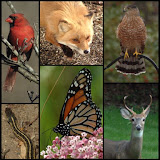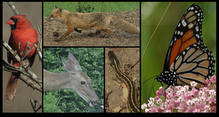 This red-shouldered hawk, along with its mate, appeared in the Colvin Run Habitat early last March. They were observed perched, calling, and flying together for over an hour.
This red-shouldered hawk, along with its mate, appeared in the Colvin Run Habitat early last March. They were observed perched, calling, and flying together for over an hour.
 They had been seen for a few minutes at a time for the preceding month. Given the time and the amount of calling this day, I believe that they proceeded to the top of one of the white pine for mating.
They had been seen for a few minutes at a time for the preceding month. Given the time and the amount of calling this day, I believe that they proceeded to the top of one of the white pine for mating.
 I include them here for two reasons. First, I used the third photo (using markings on a branch cropped out of the photo) to measure the wingspan of this hawk after the fact. The wingspan measure 64" (yes 5 foot 4 inches). Given the size, I believe that this is the female of the pair. Given the markings, I believe that this is a realatively young (on the immature side) hawk.
I include them here for two reasons. First, I used the third photo (using markings on a branch cropped out of the photo) to measure the wingspan of this hawk after the fact. The wingspan measure 64" (yes 5 foot 4 inches). Given the size, I believe that this is the female of the pair. Given the markings, I believe that this is a realatively young (on the immature side) hawk.
 Second, this is an excellent example of power - consider what it took for this large, heavy hawk to simultaneously jump, spread its over 5 feet of wings, and get a down stroke in before falling back to the ground.
Second, this is an excellent example of power - consider what it took for this large, heavy hawk to simultaneously jump, spread its over 5 feet of wings, and get a down stroke in before falling back to the ground.
 These next photos show the progression from in-flight barely off the ground to being perched on a tree branch about 7 feet off the ground.
These next photos show the progression from in-flight barely off the ground to being perched on a tree branch about 7 feet off the ground.
 As it approaches its targeted perch, the hawk seeks more lift and less speed. Similar to an airplane, the hawk puts its flaps down.
As it approaches its targeted perch, the hawk seeks more lift and less speed. Similar to an airplane, the hawk puts its flaps down.
 It does this by, rotating its wings from a horizontal to a near vertical position - increasing lift and decreasing speed. All birds do this as they approach a perch. The result is that they, counter to our intuition, approach a perch from below, not from above - they flight up to, not glide down to the perch.
It does this by, rotating its wings from a horizontal to a near vertical position - increasing lift and decreasing speed. All birds do this as they approach a perch. The result is that they, counter to our intuition, approach a perch from below, not from above - they flight up to, not glide down to the perch.
 And, with that power and lift, the hawk perches on the tree branch.
And, with that power and lift, the hawk perches on the tree branch.
You might ask why the technical quality of these photos are, well shall we say, not the best. First, the hawk was in near constant motion. Second, I was in near constant motion - these photos were taken by me walking to within 30 feet of this hawk. Third, the photos were taken on a cloudy day - not lots of light. The telephoto lense that I was using requires lots of light, else the shutter speed and aperture are not optimal for crisp photos. Fourth, the hawk is flying among tree branches. These tree branches confuse the camera's autofocus mechanism. In short, subject and photographer moving, low light, and focus in progress as photo is shot. Oh, to be sitting still to take slow walking marine birds on a beach in sunny Florida.
 Back in the fall of 2003, we took an extended weekend trip to Cape Cod and included a ferry ride from Falmouth to Martha's Vineyard.
Back in the fall of 2003, we took an extended weekend trip to Cape Cod and included a ferry ride from Falmouth to Martha's Vineyard. There is nothing like a daily ferry with tourist to attrack sea gulls. Of course, a crew member throwing popcorn from the top deck helps also.
There is nothing like a daily ferry with tourist to attrack sea gulls. Of course, a crew member throwing popcorn from the top deck helps also. The gulls came within 10 feet of the top deck - the gulls got popcorn while I got lots of photos.
The gulls came within 10 feet of the top deck - the gulls got popcorn while I got lots of photos. All of these are Herring Gulls, a common gull found throughout North America.
All of these are Herring Gulls, a common gull found throughout North America. Without a reference in these photos it is hard to appreciate that these gulls are the size of a red-shouldered hawk with a 4 1/2 foot wingspan.
Without a reference in these photos it is hard to appreciate that these gulls are the size of a red-shouldered hawk with a 4 1/2 foot wingspan. The Herring Gull is part of a complex of large, white-headed gulls that breed across the northern hemisphere. Some people consider all of the forms as one species, while others would recognize 10 or more species. [Cornell]
The Herring Gull is part of a complex of large, white-headed gulls that breed across the northern hemisphere. Some people consider all of the forms as one species, while others would recognize 10 or more species. [Cornell]








